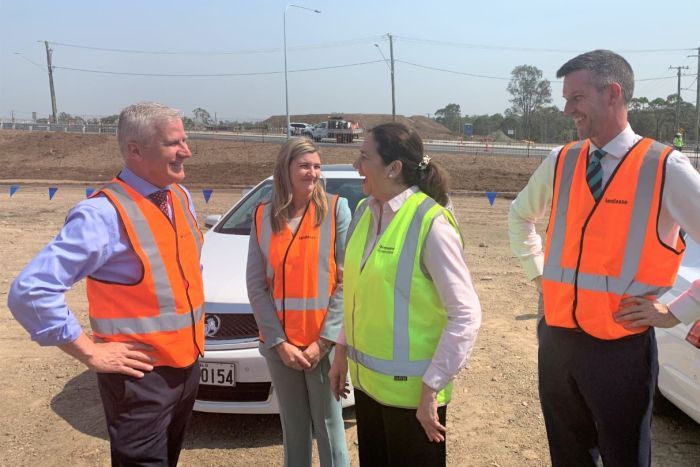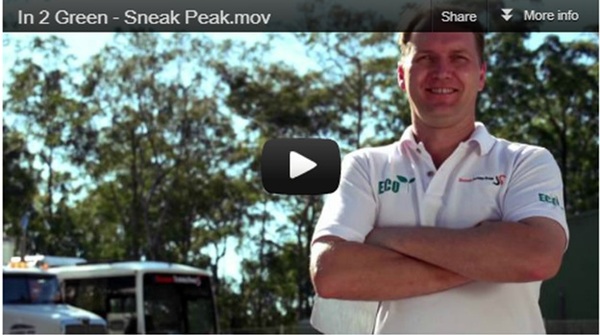
by Kim Kennedy | Nov 21, 2019 | Latest News, QTLC At Work, QTLC Updates, Rail News, Road News
Queensland Transport and Logistics Council welcomes the federal government move to bring forward infrastructure funding commitments to stimulate the economy. For Queensland this includes a $1.9 billion road and rail package with $650 million funding brought forward and a new commitment of $680 million.
The Queensland Government has committed a further $606 million and estimates more than 7,200 jobs will be created. Premier Annastacia Palaszczuk called the historic deal a “huge win”.
“I have always said we work best when we work together and this proves it,” she said.
Queensland can expect a steady flow of road and rail upgrades over the next four years with 20 projects brought forward including M1, Bruce highway, Warrego highway, Cunningham highway and $90 million for the North Coast Rail Line Beerburrum and Nambour upgrade. Further detail on the breakdown of project spending can be found in the media release here.
The ABC reported that Queensland Transport Minister Mark Bailey said the arrangement was particularly successful because it involved a shift in a stalemate regarding the Inland Rail project.
“Inland Rail presents an opportunity to move more freight onto trains and take trucks off the roads”, he said.
“That becomes more important as South East Queensland continues to grow.
“This deal also prioritises planning for the passenger rail services that will be needed to serve growing parts of South East Queensland, like the Salisbury to Beaudesert rail link.”
The Queensland section of this nation building rail project is significant with an estimated $7 billion greenfield investment including tunnelling through the Toowoomba Range.
There are many issues with Inland rail yet to be carefully navigated including the alignment of the Condamine flood plain section. Meaningful progress on these concerns can now be achieved with an agreement in place.
The CEO of ARTCs Inland Rail group, Richard Wankmuller said at the Inland Rail conference earlier in the year that ARTC had learned many lessons about consultation working with effected communities along the line.
Richard said he was not surprised by the anger expressed by Condamine producers about the rail alignment considering all other infrastructure projects have washed away during severe flooding events. The answer it seems is technology and advanced engineering see earlier article on the conference here.
The Port of Brisbane won’t miss out either with $20 million funding set aside for a detailed study into the rail connection to the port.
Port of Brisbane CEO Roy Cummins said the announcement is a step in the right direction.
Funding a business case will allow all parties to assess demand, financing, design and timing for this project. It should also lead to corridor preservation as an immediate priority.
Details are yet to be ironed out and no doubt a steady stream of project announcements will follow in coming weeks.
by Nic ki | Jul 24, 2013 | QTLC At Work, QTLC Updates
Supply Chain efficiencies have always been of paramount importance to the freight industry and the issue it is now gaining increased attention from all tiers of government that recognise the economic and community benefits these efficiencies deliver.
Since its release The QTLC’s Strengthening Queensland’s Supply Chains has received support from both industry and government for addressing the existing issues that impact on the efficiency of supply chains. The 52 recommendations contained within the report focus on low cost, innovative, systemic solutions to addressing these issues. It is intended that the SQSC will be a “live” document that is reviewed bi-annually and is responsive to changes in the freight environment.
The QTLC had an opportunity to discuss elements of the report with the Queensland Premier who was supportive of the initiatives identified, particularly those relating to rail and agricultural commodities.
The report makes strategic and operational recommendations to improve the development and sustainability of efficient and productive supply chains in Queensland. It also identifies freight transport and logistics infrastructure investment and necessary policy, planning and process reforms required to support the future freight task in Queensland.
To view the Strengthening Queensland’s Supply Chains Report please CLICK HERE

by S M G | Oct 5, 2012 | QTLC At Work

Catch a sneak peak of In 2 Green

click to view the video
Are you interested in…

- Reducing carbon emission?
- Getting the competitive edge?
- Implementing good environmental practices?
- Reaping the financial benefits of going green?
- Gaining a reputation for being environmentally conscious?
Then register now to attend one of the FREE workshops held in October
When?
There are four workshops that you can choose from:

How to register
You can register your attendance in one of two ways:
- Complete the online registration form by clicking here or
- Contact Nicki Milios on 07 3306 7432 or admin@v2.qtlc.com.au
Want more information?
If you would like more information on these FREE workshops:
by S M G | Jul 6, 2012 | QTLC At Work
Advice Provided to Lord Mayor Graham Quirk on Kingsford Smith Drive Upgrade
Thank you for providing the Queensland Transport and Logistics Council (QTLC) with the opportunity to review your plans for the proposed upgrade of Kingsford Smith Drive and for taking the time to walk me through the proposal at our recent meeting.
The QTLC is the peak body for the freight and logistics industry in Queensland; hence we are vitally concerned to ensure that freight movement, by whatever mode, is fully and properly considered in any planning context. We are also well aware that freight transport, particularly in Brisbane, is growing at a rate far exceeding that of population growth and, as such, represents an increasing proportion of the contribution to urban congestion.
Nevertheless, personal vehicles will continue to predominate as the root cause of congestion in Brisbane, particularly in the case of KSD as it represents the only viable route and means of transport for the many people finding employment within the growing Australia Trade Coast (ATC) precinct.
We are also aware that KSD represents one of the most highly trafficked freight routes under BCC control and provides an important link for freight consumers and generators nearby, including the CBD. The construction industry in particular is very reliant on KSD to afford timely access to project sites.
Whilst the phasing out of cargo shipping operations in the Hamilton Reach and the advent of alternative routes for freight will go some way to reducing heavy freight movements along the corridor, there will remain a significant number of businesses reliant on timely freight deliveries within the Hamilton area. As the process or urban renewal takes its inevitable course and commuter numbers continue to grow, it must be recognised that freight movements will also grow to satisfy local demand for basic essentials.
In terms of benefits to freight transport from the proposed upgrade of KSD, may I offer the following observations:
Increased public transport capacity
The QTLC, whilst being a strong advocate for the freight industry, appreciates the benefits that mass public transport options (both road and rail) can deliver in terms of relieving peak congestion. We also appreciate that putting more buses on an already congested route is likely to do little to increase patronage. Hence we are supportive of measures which will increase the viability of public transport options which will not impose on the freight existing capacity of KSD. This implies a need to upgrade KSD to accommodate bus capacity.
ATC
We, in South-east Queensland, are much the envy of our southern counterparts because we had the foresight to establish the ATC as a hub for industrial activity, including for freight and logistics capacity to serve the region. This vision is now being reflected in significant private sector investment both in the sea and airports as well as by industries which can capitalise on being in close proximity to these assets. KSD will continue to be a significant corridor in terms of freight movement to and from the ATC, given the proposed constraints on freight movement on the Airport Link Project and already implemented for Clem7.
Air Freight
Air freight, whilst not significant in terms of the volume of freight moving around SEQ, is nonetheless valuable and usually time sensitive. Although Brisbane airport is now proximate to a functioning Gateway Motorway there remains a need for this freight traffic to access parts of the City not well served by other corridors such as the Airport Link project.
The growing market for imported goods sourced over the internet is leading to significant growth in the number of light commercial vehicles accessing the road network and many of these trips have their origin and destination at the airport freight terminals.
Distribution Centres
There are a growing number of both importers and domestic freight generators which are logically siting their DCs in the ATC precinct, many of which can be best served from an upgraded KSD.
Whilst the eastern end of KSD, on which Council has already commenced much appreciated upgrades, is of key importance for the use of freight efficient vehicles and thus provides robust linkages to major arterial routes, KSD west of the Gateway Motorway is a vital link for light freight making its way to and from the region as a whole.
The QTLC’s abiding desire is that, whatever upgrade option is ultimately selected, it provides capacity for freight not afforded by circuitous alternatives or tolled options and those businesses adjacent to the corridor, of which there are many, can get access to the goods they need to support the ambitions of higher residential densities in the area.
Thank you again for offering the QTLC the opportunity to lend its support to this valuable and important project and please note that we are more than willing to provide further support in answer to specific issues should they arise.
by S M G | Jul 6, 2012 | QTLC At Work
The Queensland Transport and Logistics Council (QTLC), as the peak industry body for the freight transport and logistics industry in Queensland, acknowledges that this document represents a unique opportunity to formalise and participate in the shaping of our industry’s future for many years to come. Our constituents, many of which you have heard from already, are concerned to ensure that freight, for once, is not treated as an afterthought when it comes to planning the Region’s future and that it does, indeed, form a central plank of the SEQ 2031 strategy and planning membrane.
At the outset, let me say that the QTLC is impressed with the quality of the document and the virtues of having a well-considered and strategic approach for network planning. It is also reassuring that freight has been given a higher profile than that afforded in similar planning instruments which have been developed in the past.
That said, however, we are concerned that SEQ 2031 falls short of identifying some key issues impacting on the efficiency of freight movement within the region, not only now but in years to come. In short, there is a demonstrated lack of vision for the freight network in a document that purports to provide a framework for planning over the next 20 years.
For instance, only projects which are underway or currently being planned are mentioned. (The Port of Brisbane Motorway upgrade is inexplicably not listed). It would be of great assistance to industry and future planning if there were some aspirational targets included as part of the strategy other than those which are currently stalled for lack of investment or mired in planning approval processes.
To put this another way, the freight section of SEQ 2031 should outline a vision as to how the policy ambitions are going to be achieved. At the moment, the freight network strategy suggests that the industry just has to make do with the infrastructure that passenger transport outcomes dictate. SEQ 2031 should also make reference to the Integrated Freight Strategy for Queensland as a key point of reference in formulating the policy framework adopted for setting the response to freight issues which permeate the study area.
Rail
There is little doubt, either statistically or commercially, that rail freight in and out of SEQ is under pressure from road transport and has been for many years. One of the largest failings we see in the document, as currently drafted, is the homage paid to the undisclosed benefits of moving more freight on rail; both into and around the region. These benefits are neither well articulated nor supported by actions within SEQ 2031. It is commonly understood that passenger services are planned to increase substantially across the Citytrain network with contracts having already been let for more rolling stock and track capacity for commuter services. Yet somehow the concept of a rail shuttle service for containerised freight is being proposed without any consideration of how such a service could operate in this commuter led rail planning environment.
Moreover, how could a rail shuttle service compete with a heavily Government subsidised passenger railway operation with the added protection of legislated passenger priority?
The bulk rail freight traffics into the Port of Brisbane are also in danger of becoming obsolete unless there is a commitment to upgrade the rail link to Toowoomba and beyond to capture this traffic for rail, however, SEQ 2031 is silent on both these issues. Is there a plan to at least keep bulk traffics to the port on rail? Is the Government pinning its hopes on the South Burnett Rail going ahead and bulk traffic being diverted to Gladstone? Industry needs certainty on these issues to both garner investment or avoid investing in stranded assets.
If the idea is to facilitate intermodal terminals at Ebenezer and to the north of Brisbane in an as yet undisclosed location as a means of circumventing the impending rail impasse to the POB then SEQ 2031 needs to acknowledge this with an appropriate plan to increase road freight capacity to the port.
In short, the Government must make a call as to how it proposes to manage rail freight in SEQ; it must either be facilitated or abandoned in favour of another strategy to fill the void. The QTLC’s fear is that, without an emphatic vision, scarce resources will be consumed to support unsustainable outcomes.
Intermodal
The Intermodal terminal strategy, whilst robust in its conception and choice of locations, is not backed up with a strategy to facilitate the linkages required to make these terminals attractive for private sector investment. An intermodal terminal which can’t be accessed by high productivity vehicles is doomed to fail, especially if the ultimate destination of the freight is in the Brisbane City LGA.
Road
There is no mention of the need for high productivity vehicles to be given a broader range of movement within SEQ even though the Queensland Government has signed up for various reforms/ initiatives at a National level. There seems to be a culture developing whereby Queensland, and indeed other states, pay lip service to the National Agenda but then shy away from providing access due to untested political consequences.
We note that the decision to run PBS approved A-Double combinations between Toowoomba and Brisbane for the haulage of grain failed to ignite any public backlash against the Government, yet there seems to be some instilled fear of broadening the use of PBS vehicles except in a crisis.
You must admit that there is a glaring irony in the fact the HPVs can traverse some of the poorest roads in the state but cannot operate on our few priority freight routes (arguably some of the best roads in the country) within SEQ.
The QTLC recognises that the Government is aware of the scarcity of breakdown areas available to support the policy of excluding HPVs from the so called priority freight network, however, there is a distinct disconnect between the timeliness of delivery and the volume of traffic needing to access these facilities. Again, the government must make a choice between pursuing a policy of exclusion for HPVs or facilitate a workable interface between access restrictions. SEQ2031 does not countenance this important issue.
The same can be said of the need to accommodate higher mass limits (HML) and permitted road use on SEQ roads. As approval is granted for major infrastructure and mining projects there does not appear to be any correlating consideration of the need to move machinery or plant components into and out of the region for installation or repair in order to facilitate these core economic activities.
The QTLC strongly believes that a route or routes to the west and north of the region should be identified for such movements and funded accordingly to provide an unambiguous plan for the movement of such freight for both users and regulators.
Planning
The QTLC is encouraged by the fact that freight is being afforded at least some consideration in land use planning. Yet we see potential conflicts emerging from planning documents which, while physically separating transport and logistics hubs from residential encroachment, require both freight and personal transport to share scarce transport infrastructure. Proposed developments at Flagstone (residential) and Bromelton (T&L) being a case in point.
It is also clear from reading the document that decisions are being made about the freight network based on some very old data and projections. Some of the unique studies referenced in SEQ 2031 are based on more timely data, however, the bulk of the assumptions used to highlight potential growth are based on figures which are well out of date. The QTLC would like to see a commitment from the Government to improved data collection and would be happy to support efforts to garner industry support for such an initiative.





